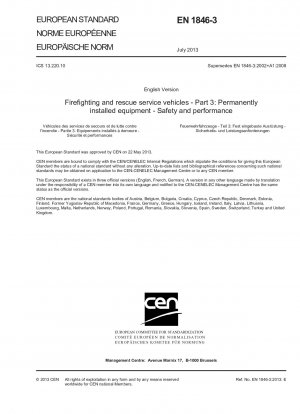EN 1846-3-2013(1)
Firefighting and rescue service vehicles - Part 3: Permanently installed equipment - Safety and performance
- Standard No.
- EN 1846-3-2013(1)
- Published By
- European Committee for Standardization (CEN)
- Scope
- This part of this European Standard specifies the minimum requirements for safety and performance of some optional specific permanently installed equipment on firefighting and rescue service vehicles, operated by trained persons, as designated in EN 1846-1 and specified in EN 1846-2. NOTE Categories and mass classes of the firefighting and rescue service vehicles are given in EN 1846-1. The permanently installed equipment covered by this Part of this European Standard is given below: water installation; liquid additive installation; monitor; equipment gantries; demountable systems using a hydraulic hook arm. This part of this European Standard should be read in conjunction with any national regulations in force for vehicles using the public roads and with any EU Directives and associated EFTA regulations in force relevant to vehicles and their equipment. For the purposes of this European Standard, the normal ambient temperature range is - 15 °C to + 35 °C. For equipment to be used at temperature outside this temperature range, the particular temperature range should be specified by the user and the manufacturer should determine by a risk assessment any need for additional precautions. This European Standard does not deal with the following types of fire-fighting or rescue vehicles or equipment: all control systems outside of the cabin related to hook arm system; vehicles designed exclusively for carrying personnel; vehicles with a gross laden mass not exceeding 3 t; boats; aircraft; railway vehicles; ambulances (see EN 1789); provisions for removable equipment driven by PTO; airport vehicles in the scope of the recommendations of the International Civil Aviation Organisation (ICAO). This part of this European Standard deals with the technical requirements to minimise the hazards listed in Clause 4 which can arise during operational use, routine checking and maintenance of firefighting and rescue service vehicles. It does not cover the hazards generated by: non-perma
